[English] 日本語
 Yorodumi
Yorodumi- PDB-6w19: Structures of Capsid and Capsid-Associated Tegument Complex insid... -
+ Open data
Open data
- Basic information
Basic information
| Entry | Database: PDB / ID: 6w19 | |||||||||||||||
|---|---|---|---|---|---|---|---|---|---|---|---|---|---|---|---|---|
| Title | Structures of Capsid and Capsid-Associated Tegument Complex inside the Epstein-Barr Virus | |||||||||||||||
 Components Components |
| |||||||||||||||
 Keywords Keywords | VIRUS / gamma-herpesvirus / EBV / CATC / Structural plasticity | |||||||||||||||
| Function / homology |  Function and homology information Function and homology informationT=16 icosahedral viral capsid / viral capsid assembly / viral process / viral capsid / host cell nucleus / structural molecule activity / DNA binding Similarity search - Function | |||||||||||||||
| Biological species |  Epstein-Barr virus (Epstein-Barr virus) Epstein-Barr virus (Epstein-Barr virus) | |||||||||||||||
| Method | ELECTRON MICROSCOPY / single particle reconstruction / cryo EM / Resolution: 5.5 Å | |||||||||||||||
 Authors Authors | Liu, W. / Cui, Y.X. / Wang, C.Y. / Li, Z.H. / Gong, D.Y. / Dai, X.H. / Bi, G.Q. / Sun, R. / Zhou, Z.H. | |||||||||||||||
| Funding support |  United States, 4items United States, 4items
| |||||||||||||||
 Citation Citation |  Journal: Nat Microbiol / Year: 2020 Journal: Nat Microbiol / Year: 2020Title: Structures of capsid and capsid-associated tegument complex inside the Epstein-Barr virus. Authors: Wei Liu / Yanxiang Cui / Caiyan Wang / Zihang Li / Danyang Gong / Xinghong Dai / Guo-Qiang Bi / Ren Sun / Z Hong Zhou /   Abstract: As the first discovered human cancer virus, Epstein-Barr virus (EBV) causes Burkitt's lymphoma and nasopharyngeal carcinoma. Isolating virions for determining high-resolution structures has been ...As the first discovered human cancer virus, Epstein-Barr virus (EBV) causes Burkitt's lymphoma and nasopharyngeal carcinoma. Isolating virions for determining high-resolution structures has been hindered by latency-a hallmark of EBV infection-and atomic structures are thus available only for recombinantly expressed EBV proteins. In the present study, by symmetry relaxation and subparticle reconstruction, we have determined near-atomic-resolution structures of the EBV capsid with an asymmetrically attached DNA-translocating portal and capsid-associated tegument complexes from cryogenic electron microscopy images of just 2,048 EBV virions obtained by chemical induction. The resulting atomic models reveal structural plasticity among the 20 conformers of the major capsid protein, 2 conformers of the small capsid protein (SCP), 4 conformers of the triplex monomer proteins and 2 conformers of the triplex dimer proteins. Plasticity reaches the greatest level at the capsid-tegument interfaces involving SCP and capsid-associated tegument complexes (CATC): SCPs crown pentons/hexons and mediate tegument protein binding, and CATCs bind and rotate all five periportal triplexes, but notably only about one peri-penton triplex. These results offer insights into the EBV capsid assembly and a mechanism for recruiting cell-regulating factors into the tegument compartment as 'cargoes', and should inform future anti-EBV strategies. | |||||||||||||||
| History |
|
- Structure visualization
Structure visualization
| Movie |
 Movie viewer Movie viewer |
|---|---|
| Structure viewer | Molecule:  Molmil Molmil Jmol/JSmol Jmol/JSmol |
- Downloads & links
Downloads & links
- Download
Download
| PDBx/mmCIF format |  6w19.cif.gz 6w19.cif.gz | 4.7 MB | Display |  PDBx/mmCIF format PDBx/mmCIF format |
|---|---|---|---|---|
| PDB format |  pdb6w19.ent.gz pdb6w19.ent.gz | Display |  PDB format PDB format | |
| PDBx/mmJSON format |  6w19.json.gz 6w19.json.gz | Tree view |  PDBx/mmJSON format PDBx/mmJSON format | |
| Others |  Other downloads Other downloads |
-Validation report
| Summary document |  6w19_validation.pdf.gz 6w19_validation.pdf.gz | 1.7 MB | Display |  wwPDB validaton report wwPDB validaton report |
|---|---|---|---|---|
| Full document |  6w19_full_validation.pdf.gz 6w19_full_validation.pdf.gz | 1.7 MB | Display | |
| Data in XML |  6w19_validation.xml.gz 6w19_validation.xml.gz | 602.9 KB | Display | |
| Data in CIF |  6w19_validation.cif.gz 6w19_validation.cif.gz | 956.9 KB | Display | |
| Arichive directory |  https://data.pdbj.org/pub/pdb/validation_reports/w1/6w19 https://data.pdbj.org/pub/pdb/validation_reports/w1/6w19 ftp://data.pdbj.org/pub/pdb/validation_reports/w1/6w19 ftp://data.pdbj.org/pub/pdb/validation_reports/w1/6w19 | HTTPS FTP |
-Related structure data
| Related structure data |  21504MC  6w2dC  6w2eC M: map data used to model this data C: citing same article ( |
|---|---|
| Similar structure data |
- Links
Links
- Assembly
Assembly
| Deposited unit | 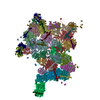
|
|---|---|
| 1 | x 60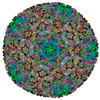
|
| 2 |
|
| 3 | x 5
|
| 4 | x 6
|
| 5 | 
|
| Symmetry | Point symmetry: (Schoenflies symbol: I (icosahedral)) |
- Components
Components
| #1: Protein | Mass: 154086.828 Da / Num. of mol.: 16 / Source method: isolated from a natural source Source: (natural)  Epstein-Barr virus (strain B95-8) (Epstein-Barr virus (strain B95-8)) Epstein-Barr virus (strain B95-8) (Epstein-Barr virus (strain B95-8))Strain: B95-8 / References: UniProt: P03226 #2: Protein | Mass: 18169.100 Da / Num. of mol.: 16 / Source method: isolated from a natural source Source: (natural)  Epstein-Barr virus (strain B95-8) (Epstein-Barr virus (strain B95-8)) Epstein-Barr virus (strain B95-8) (Epstein-Barr virus (strain B95-8))Strain: B95-8 / References: UniProt: P14348 #3: Protein | Mass: 39231.539 Da / Num. of mol.: 6 / Source method: isolated from a natural source Source: (natural)  Epstein-Barr virus (strain B95-8) (Epstein-Barr virus (strain B95-8)) Epstein-Barr virus (strain B95-8) (Epstein-Barr virus (strain B95-8))Strain: B95-8 / References: UniProt: P03187 #4: Protein | Mass: 33654.039 Da / Num. of mol.: 12 / Source method: isolated from a natural source Source: (natural)  Epstein-Barr virus (strain B95-8) (Epstein-Barr virus (strain B95-8)) Epstein-Barr virus (strain B95-8) (Epstein-Barr virus (strain B95-8))Strain: B95-8 / References: UniProt: P25214 |
|---|
-Experimental details
-Experiment
| Experiment | Method: ELECTRON MICROSCOPY |
|---|---|
| EM experiment | Aggregation state: PARTICLE / 3D reconstruction method: single particle reconstruction |
- Sample preparation
Sample preparation
| Component | Name: Human herpesvirus 4 strain B95-8 / Type: VIRUS / Entity ID: all / Source: NATURAL |
|---|---|
| Molecular weight | Experimental value: NO |
| Source (natural) | Organism:  Human herpesvirus 4 strain B95-8 (Epstein-Barr virus (strain B95-8)) Human herpesvirus 4 strain B95-8 (Epstein-Barr virus (strain B95-8)) |
| Details of virus | Empty: NO / Enveloped: YES / Isolate: STRAIN / Type: VIRION |
| Buffer solution | pH: 7.4 / Details: PBS buffer, pH 7.4 |
| Specimen | Embedding applied: NO / Shadowing applied: NO / Staining applied: NO / Vitrification applied: YES |
| Specimen support | Grid material: COPPER / Grid mesh size: 200 divisions/in. / Grid type: Quantifoil R2/1 |
| Vitrification | Instrument: HOMEMADE PLUNGER / Cryogen name: ETHANE / Details: The grids were manually plunged into the ethane. |
- Electron microscopy imaging
Electron microscopy imaging
| Experimental equipment |  Model: Titan Krios / Image courtesy: FEI Company |
|---|---|
| Microscopy | Model: FEI TITAN KRIOS |
| Electron gun | Electron source:  FIELD EMISSION GUN / Accelerating voltage: 300 kV / Illumination mode: FLOOD BEAM FIELD EMISSION GUN / Accelerating voltage: 300 kV / Illumination mode: FLOOD BEAM |
| Electron lens | Mode: BRIGHT FIELD / Nominal magnification: 105000 X / Calibrated magnification: 105000 X / Nominal defocus max: 4000 nm / Nominal defocus min: 800 nm / Calibrated defocus min: 800 nm / Calibrated defocus max: 4000 nm / Cs: 2.7 mm / Alignment procedure: COMA FREE |
| Specimen holder | Cryogen: NITROGEN / Specimen holder model: FEI TITAN KRIOS AUTOGRID HOLDER |
| Image recording | Electron dose: 28 e/Å2 / Film or detector model: GATAN K2 SUMMIT (4k x 4k) / Num. of real images: 1833 |
- Processing
Processing
| EM software | Name: CTFFIND / Category: CTF correction |
|---|---|
| CTF correction | Type: PHASE FLIPPING AND AMPLITUDE CORRECTION |
| Particle selection | Num. of particles selected: 2801 |
| 3D reconstruction | Resolution: 5.5 Å / Resolution method: FSC 0.143 CUT-OFF / Num. of particles: 2048 / Symmetry type: POINT |
 Movie
Movie Controller
Controller













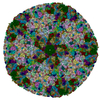
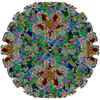
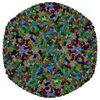
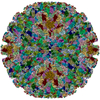


 PDBj
PDBj
